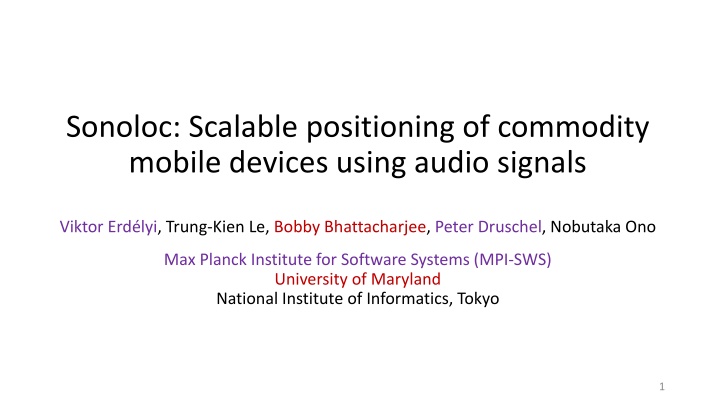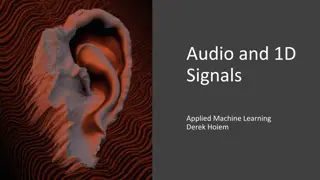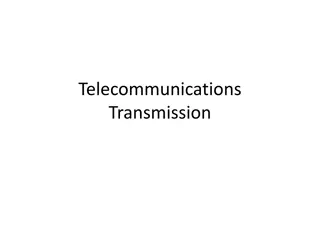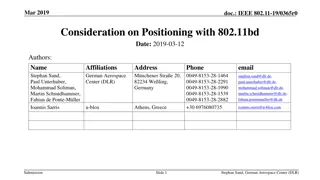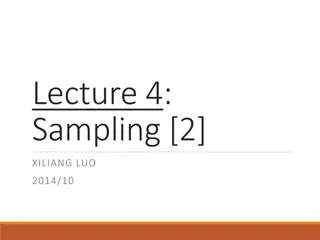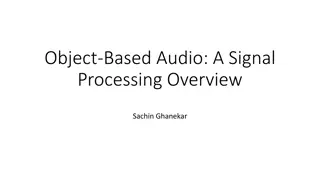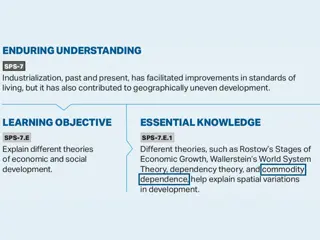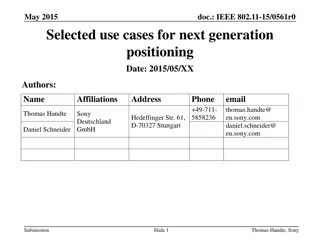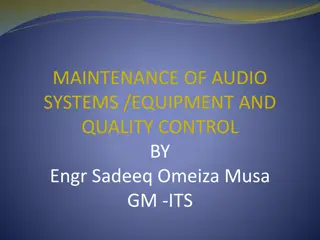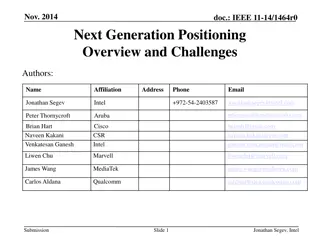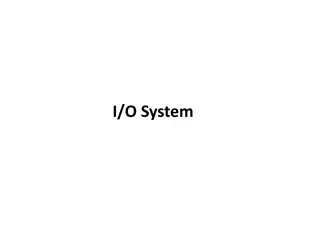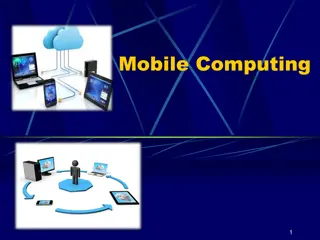Scalable Positioning of Commodity Mobile Devices Using Audio Signals
This study by Viktor Erdlyi, Trung-Kien Le, Bobby Bhattacharjee, Peter Druschel, and Nobutaka Ono explores the innovative approach of utilizing audio signals for scalable positioning of mobile devices. The research addresses the challenges and constraints related to accurate positioning, infrastructure requirements, and hardware limitations, providing insights into potential solutions for enhanced device positioning in various scenarios such as auditorium events, Q&A sessions, and map accuracy. The findings shed light on the limitations of existing technologies and propose novel methods for enhancing relative positioning based on pairwise distances, offering a glimpse into the future of mobile device positioning technologies.
Uploaded on Mar 06, 2025 | 1 Views
Download Presentation

Please find below an Image/Link to download the presentation.
The content on the website is provided AS IS for your information and personal use only. It may not be sold, licensed, or shared on other websites without obtaining consent from the author.If you encounter any issues during the download, it is possible that the publisher has removed the file from their server.
You are allowed to download the files provided on this website for personal or commercial use, subject to the condition that they are used lawfully. All files are the property of their respective owners.
The content on the website is provided AS IS for your information and personal use only. It may not be sold, licensed, or shared on other websites without obtaining consent from the author.
E N D
Presentation Transcript
Sonoloc: Scalable positioning of commodity mobile devices using audio signals Viktor Erd lyi, Trung-Kien Le, Bobby Bhattacharjee, Peter Druschel, Nobutaka Ono Max Planck Institute for Software Systems (MPI-SWS) University of Maryland National Institute of Informatics, Tokyo 1
Addressing recipients based on relative position Seated dinner at an event Auditorium: distributing exams Alice Person of interest Lecturer 2
Tagging messages with the sender's position Audiovisual experience feedback Q&A session Speaker Stage or screen Questioner w/ mic 3
2D relative position map Accurate Scalable to 100s of devices No local infrastructure No special hardware Enable communication: each node is associated with an electronic ID Challenge: satisfy all constraints at once 4
State of the art Requires local infrastructure Centaur (Nandakumar et al., Mobicom 2012) Requires special hardware PinPoint (Youssef et al., MobiSys 2006) Is not accurate enough to place people into a particular seat EZ Localization (Chintalapudi et al., MobiCom 2010) Acoustic signals: at least one beep per device does not scale BeepBeep (Peng et al., SenSys 2007) 5
Pairwise distance estimation via BeepBeep (Peng et al., SenSys 2007) Cannot directly measure time of flight Cannot assume synchronized clocks Unknown delays in the audio software stack ? time Device B Audio chirp Exchange of ? and ? (e.g., Bluetooth) Audio chirp Device A ? PropTimeA B+ PropTime? ? ? ? 6
Relative positioning based on pairwise distances Constraint solving (Le et al., EUSIPCO 2016) ?11 ??1 ?1? ??? 2D relative position map All pairwise distances Problem: needs at least one transmission from each participant Does not scale 7
Sonoloc 8
Assumptions Participants carry a smart device Within audible distance Unobstructed line of sight Stationary devices (during measurement) Small vertical (Z) offsets (due to 2D loc.) 9
Key idea: 2 phases Phase 1 Choose a small subset of devices as audio transmitters All others are silent Assign relative coordinates to just the transmitters Passive device Transmitter device Pairwise distance 10
Phase 2: localizing the remaining, passive devices Distance diff. constraints Passive devices only listen T1,T2,P: Time diff. of arrival of 2 signals at all 3 locations distance difference ??2,? ??1,? ??3,? ??1,? ??4,? ??1,? P ??1,? Constraint solving (Stoica et al., IEEE Signal Processing Magazine 2006) T1 Transmitter positions ??2,? T2 ??4,? ??3,? Position of P Passive device Transmitter device Distance difference Pairwise distance To localize all passive devices: repeat for each T3 T4 11
How to choose transmitters? Poor choices of transmitters Good choices of transmitters Intuition: choose on convex hull (based on map) Accurate position map Good transmitter choice Passive device Transmitter device 12
Iterative transmitter selection algorithm 1. 2. 3. 4. 5. Small, random set of transmitters Position all devices Choose an additional transmitter: maximize convex hull of transmitters New transmitter transmits one signal Go to step 2 Passive device Transmitter device 13
Iterative transmitter selection algorithm Passive device Transmitter device 14
Iterative transmitter selection algorithm Passive device Transmitter device 15
Iterative transmitter selection algorithm Stop at the specified number of transmitters Passive device Transmitter device 16
Evaluation Simulations and real experiments 17
Simulations: various device layouts Clustered Cafeteria (36 tables, 4x2 each) Concentric circles Random (quadratic or circular space) Banquet Small restaurant (6 tables, 3x2 each, 30 occupied randomly) Lecture hall 20 x 20 seats, 100 occupied randomly Conference room (15 x 2) (10 round tables, 12 devices each) We also simulate signal processing inaccuracy, Z-offsets, temperature influence, sampling rate mismatch 18
Real-world deployment Several rooms with different shapes, sizes, acoustic properties Several background noise types (silent, speech, music) 100 passive devices = 100 microphones + 100 Raspberry Pis 15 transmitters = 15 smartphones 19
Simulation results (aggregated) Max IPDE vs. number of transmitters Evaluation metric: Interpoint distance error (IPDE) Absolute difference between: Ground-truth distance Estimated distance (measured on the output position map) Main takeaway: 0.5m max error at 11 tr. holds for any number of passive devices 6 9 12 15 Number of transmitters 20
Max IPDE vs. number of transmitters Simulation (aggregated) Real experiments (aggregated) Sound cards & microphones used with Raspberry Pis have lower quality than our phones. 6 9 12 15 Number of transmitters 6 9 12 15 Number of transmitters 0.5m max error at 15 tr. 0.5m max error at 11 tr. 21
Summary Sonoloc: a method to compute a 2D relative position map of smart devices within acoustic range Can scale to 100s of devices No local infrastructure needed Works with commodity hardware Requires only a constant number of audio signals (15) 22
